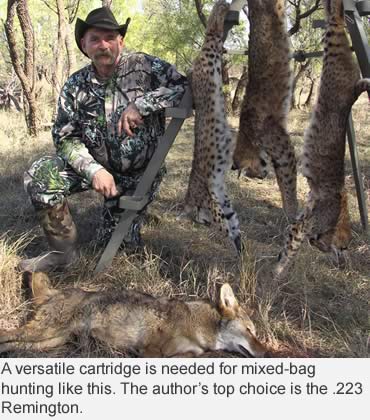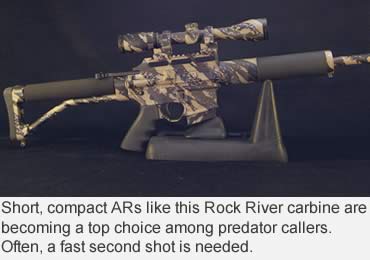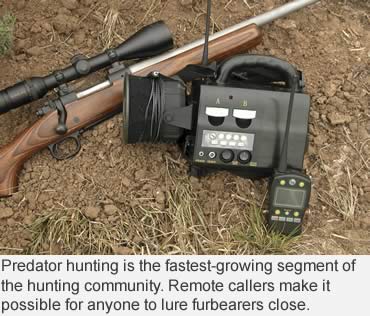By Ralph M. Lermayer
Electronic callers make predator hunting easy. Here’s where to set up and what firepower to bring for success.
The introduction and rapid acceptance of wireless remote-controlled electronic callers has moved predator hunting from a sport enjoyed by a small part of the hunting community into the fastest-growing segment of the shooting sports. With e-calls, if you can push a button, you can deliver hundreds of sounds as effectively as any old time pro who has been at it for decades.
The e-call advantages are bringing shooters to predator hunting by the thousands, but it takes more than a good call to anchor the wiley ones. Here are some tips and techniques to help make you a better predator hunter.
 Coyote Calibers
Coyote Calibers
Any rifle caliber/shotgun gauge will take a coyote. Forty pounds is a really big one, with most going about half that. Sometimes they pop up in your face and other times hang way out there. The cartridge that has worked best for me, with decades of coyote calling behind me, is the .223 Rem.
Sometimes when the wind is up and the shot is long, I wish for something with more punch, like a .22-250. Other times when a prime bobcat is just 20 yards away, I wish I had less destruction. But in both instances, the .223 will get the job done.
Avoid fast-fracturing bullets designed for prairie dogs. Go with an expanding 55-grain load at about 3,000 fps, and you’ll have few regrets. Want a .204, .22-250, Hornet or .222? Go for it. They all work, but the .223 is most versatile.
Rifle
For most calling, you’re best served with a shorter, lighter rifle. Most often, you’ll be sitting low to the ground, in a less than ideal shooting position. You need a gun that swings well, doesn’t hang up, and gets on target fast. When setting up, do so from a sitting position.
 I don’t have a single favorite rifle; I have three. If I’m in open country with little hunting pressure and there is a good chance of calling in multiple dogs, I’m real fond of my short (18-inch) Rock River AR. Ninety percent of the competitors at the national and world coyote calling contests are so equipped. If the country is heavily hunted, heavily timbered, or there’s a lot of walking involved, my 18-inch T/C Encore single shot gets the nod.
I don’t have a single favorite rifle; I have three. If I’m in open country with little hunting pressure and there is a good chance of calling in multiple dogs, I’m real fond of my short (18-inch) Rock River AR. Ninety percent of the competitors at the national and world coyote calling contests are so equipped. If the country is heavily hunted, heavily timbered, or there’s a lot of walking involved, my 18-inch T/C Encore single shot gets the nod.
It handles like a long handgun with a buttstock. When I’m calling from the truck (yeah, it works), you’ll find the T/C on the dash. If really long, 250-plus-yard shots are an option, then my Savage 110 Predator, loaded hot, gets the nod because it sets best on shooting sticks. All are chambered in .223.
Scattergun
In dense cover, shotguns are very viable options. I like semiautos, but I also prefer a short barrel, and finding both in one gun can be a challenge. Short-barrel pumps or even single shots with a modified choke, stoked with heavy turkey No. 4s, T-shot or the real hot choice, tungsten, are the best medicine for thick-cover callers.
Optics
Optic choices are more about rapid target acquisition than power. A fixed 4x scope will get you by, but a 3-9x has more versatility as long as it has good light-gathering ability. I much prefer the longer than normal 4- to 6-inch eye relief, as getting a full sight picture fast at an awkward angle is paramount. Nikon, Bushnell, Leupold and others offer at least one long-eye-relief scope option, with the 6-inch eye relief models the most generous.
 The Call
The Call
Call manufacturers are in a constant frenzy trying to outdistance each other in terms of how far away their remote works. Claims of 200 yards plus abound, but who cares? The animals are going to move to the call, and you rarely want it that far away.
Most often, your call will be about 50 to 75 yards off, where you can see it, hear it and see anything approaching. A feather fluttering on an arrow shaft adds a visual attraction and tells you the wind direction. Close-cover hunters in timber seldom put the call 50 yards out unless they are on the edge of a field or clearing.
Animals will use every bit of natural cover to approach the call — brushy fence lines, timbered edges around fields and the edge of power line cuts .Set up with their route and the wind in mind.
Concealment
Total camo, including face and hands, is critical, even with the call at a distance. Movement of a bright face or hand is a dead giveaway, as is the flash of a shiny rifle barrel or stock. Again, turkey tactics rule. And don’t forget back cover. You need your human-shaped silhouette broken up by brush or rocks behind you.
Don’t make the mistake of setting up facing the call. Put it off your left shoulder (opposite for lefties). That way, you can cover a full 180 degrees with your rifle swinging on your strong side.
Read Recent GunHunter Articles:
• Best Scopes for the Buck: Shop carefully, and you can find an inexpensive scope that hangs with you year in and year out.
• Belly Down for Accuracy: Prone isn’t the fastest shooting position – nor is it always practical, but it’s by far the steadiest.
This article was first printed in the July 2011 edition of Buckmasters GunHunter Magazine. Subscribe today to have GunHunter delivered to your home.